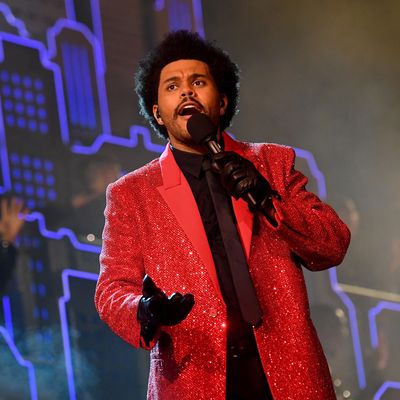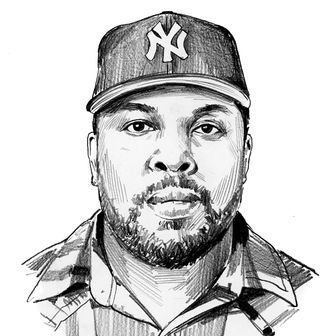
Ten winters ago, a trove of snaking, lascivious R&B tracks appeared seemingly out of thin air, credited to someone or thing called the Weeknd. They were studies in stark contrasts: “Loft Music” floated gossamer samples of Brooklyn indie rockers Beach House over trap drums, and “What You Need” sunk a sample of Aaliyah’s voice under gauzy synths, her whisper bubbling up through the watery mix like a lover emerging from a warm bath, all of this in service to an angelic voice uttering the most devilish advances. The singer, an East Toronto native and recent college dropout named Abel Tesfaye, gave voice to our darkest late-night moods, to the allure of pushing a body past its limit in pursuit of pleasures both psychedelic and carnal. In March 2011, the Weeknd released House of Balloons, a mixtape sequenced like a journey through the highs, lows, and lonesome aftereffects of a wild night out, setting the scene by advising the listener in the first song that “You’ll wanna be high for this,” then wandering through strip clubs, parties, and after parties to the inevitable anxieties and pangs of withdrawal that surface as you sweat everything out the next day. The Weeknd turned R&B on its head without showing his face. Without glossy videos or a lively social-media presence — this in the days before Instagram caught on — Abel lingered in your head like stifled urges.
In the intervening years, Tesfaye has evolved from an invisible man into a ubiquitous one, careful pivot by careful pivot, logging increasingly successful hits increasingly removed from the chunky, post-genre soup of his early mixtapes. The sound got cleaner. Tesfaye sought out pop and dance music veterans like Daft Punk and Max Martin and duetted with Ed Sheeran and Ariana Grande. He put together an accomplished live show. He honed his dance moves. He tinkered with the formula. He fashioned himself into a pop star. And on Sunday night, Tesfaye took the stage for the Super Bowl LV halftime show a decade after the early rumblings about the Toronto singer making perfect, cherubic filth. The grit from those early days was lost amid the Hollywood glamour of the display, an interesting choice for an artist whose last album spoke profoundly to a desire to leave all that behind. The show delivered a vivid array of elaborate, expensive set pieces that hit the necessary notes for a halftime gig — no matter who you get as talent, you’re getting snazzy lighting rigs, fireworks, and a massive dance routine on the field — and never missed a mark but also never really tapped into the gravity of the reality that this is probably the only live arena show most Americans have seen in a year, and it will most likely be the last that any of us will catch again until sometime next year. The halftime show — the whole night, really — felt piped in from a timeline where nothing ever went wrong.
To be fair, the Weeknd isn’t American, nor has he mixed politics with his music. Pressuring performers to pepper their music with overarching social messaging is how we end up with J-Lo screaming “Let’s Get Loud” at the presidential inauguration. The Weeknd’s specialty is escapism, pulling you into a world grislier than your own, and in the introductory minutes of his performance, the seedy, cyberpunk landscapes conjured in his latest records seemed to cross over and touch the real world. The robot choirs and dark cityscapes seen as “Call Out My Name” melted into “Starboy” brought into greater focus the feeling that the Weeknd makes music for unseen movies, soundtracks for the listener’s own personal spells of debauchery. These visuals borrowed from notable if obvious touchstones in films like Blade Runner, The Fog, Enter the Void, and the Joel Schumacher Batman films, contrasting bright city lights with a suffocating, smoky darkness. (Other, perhaps more glaring visual influences were floated throughout the night: On Twitter, it was noted that the masked and bandaged backup dancers in “Can’t Feel My Face” favored Pluto, the pyromaniacal tether from Jordan Peele’s Us, and Michael Jackson’s name came up, though what I got from the parade of red-and-black clad dancers on the field at the end of the performance was the “Thriller” number in the Super Bowl episode of Glee.) The Weeknd has earned this moment, and watching him smirking pridefully through entertaining an audience of millions was an incredible bookend to the borderline anonymity of the mixtape trilogy days (and maybe even a useful blueprint for a future residency somewhere in Las Vegas).
Jamming nine songs into a 14-minute set, the Weeknd made a case for himself as a pop phenomenon with staying power but also highlighted some of the least-interesting moments in his catalog. “The Hills” crushed, and the choir arrangement made it sound even eviler than on the record. They flubbed “I Feel it Coming,” hiking up the tempo to match “Can’t Feel My Face,” which also ran too fast. “Earned It” remains a slog. “Save Your Tears” was a highlight, though this staging couldn’t match the pyrotechnical drama we got when it was performed at the American Music Awards last year. Teasing Siouxsie and the Banshees’ “Happy House” without playing “Glass Table Girls,” the House of Balloons classic that sampled it, stung. “Blinding Lights” worked well as the requisite enormous audio/video spectacle that necessitates the aerial camera work, but what really would’ve put it over the top is finally mashing it up with A-Ha’s “Take on Me.” These picks seemed designed to nudge people toward the greatest-hits compilation,The Highlights, that was released last week in anticipation of a bump in streams after the game. (The Highlights also boasts a tracklist bafflingly short on the best Weeknd songs; one wonders how many points he’d whiff in a Verzuz.)
But there’s something dark and weird and ironic about the Weeknd in his After Hours era that’s being left off the table here. From the bandaged faces to the gaudy lounge lizard couture, the aesthetics gesture at ideas that go unexplored. As was the case with the pop-leaning songs it highlighted, this show nailed its aesthetic with ease, but it struggled to make you feel anything. (Well, maybe you started to wonder what a fully realized After Hours tour might’ve accomplished.) It felt chipper when it shouldn’t have, which was true of the entire evening, from the frustrating, continued, machine-like efficacy of Tom Brady to the obnoxious togetherness-porn of ad spots like the two-minute call from Bruce Springsteen to find common ground in the middle of the road, or the one that suggests that, actually, Gwen Stefani and Blake Shelton are polar opposites and not just different permutations of the same kind of wholesome American showbiz shmaltz. (The evening’s legitimate successes in contrast were the Corona beer ad featuring Snoop Dogg and Bad Bunny and the duet between country vet Eric Church and R&B icon Jazmine Sullivan on the national anthem, which, in spite of all the overbearing symbolism, went almost unnaturally well.)
From stem to stern, it was a night of keeping up appearances, a simulation of normalcy in a year where normal doesn’t seem possible. Maybe some people forgot about the heaviness of everything for a couple of hours last night. But at what cost? Cramming 25,000 people into a stadium during a pandemic we’ve canceled every live engagement to curtail sends a peculiar message; the imminent spike in COVID cases we’re likely to see as a result of turning Tampa Bay into a giant superspreader event can’t be worth whatever crumb of respite it delivered, though we all know, to quote a song we should’ve heard last night, the money is the motive.


